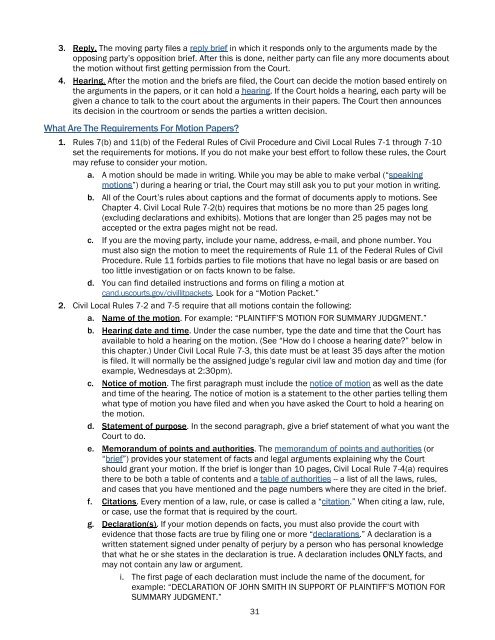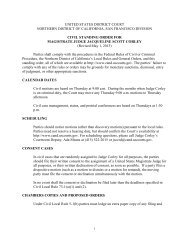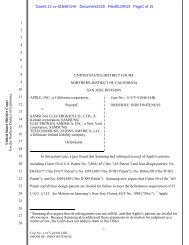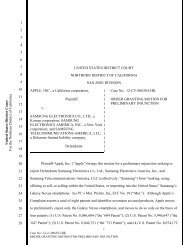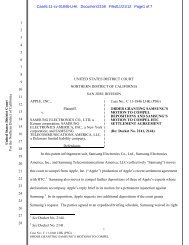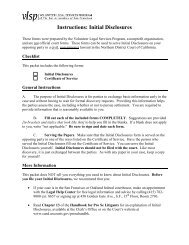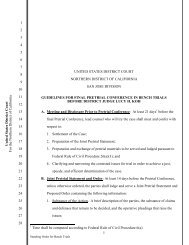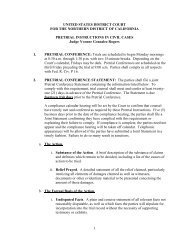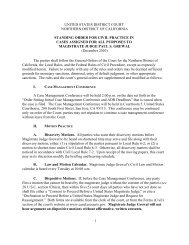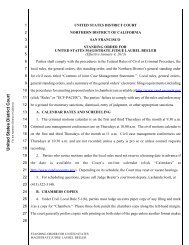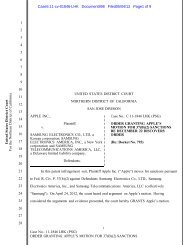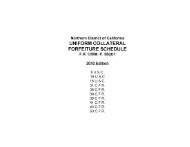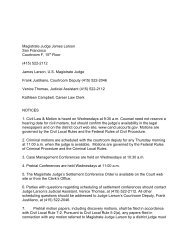Representing Yourself in Federal Court - United States District Court ...
Representing Yourself in Federal Court - United States District Court ...
Representing Yourself in Federal Court - United States District Court ...
Create successful ePaper yourself
Turn your PDF publications into a flip-book with our unique Google optimized e-Paper software.
3. Reply. The mov<strong>in</strong>g party files a reply brief <strong>in</strong> which it responds only to the arguments made by the<br />
oppos<strong>in</strong>g party’s opposition brief. After this is done, neither party can file any more documents about<br />
the motion without first gett<strong>in</strong>g permission from the <strong>Court</strong>.<br />
4. Hear<strong>in</strong>g. After the motion and the briefs are filed, the <strong>Court</strong> can decide the motion based entirely on<br />
the arguments <strong>in</strong> the papers, or it can hold a hear<strong>in</strong>g. If the <strong>Court</strong> holds a hear<strong>in</strong>g, each party will be<br />
given a chance to talk to the court about the arguments <strong>in</strong> their papers. The <strong>Court</strong> then announces<br />
its decision <strong>in</strong> the courtroom or sends the parties a written decision.<br />
What Are The Requirements For Motion Papers?<br />
1. Rules 7(b) and 11(b) of the <strong>Federal</strong> Rules of Civil Procedure and Civil Local Rules 7-1 through 7-10<br />
set the requirements for motions. If you do not make your best effort to follow these rules, the <strong>Court</strong><br />
may refuse to consider your motion.<br />
a. A motion should be made <strong>in</strong> writ<strong>in</strong>g. While you may be able to make verbal (“speak<strong>in</strong>g<br />
motions”) dur<strong>in</strong>g a hear<strong>in</strong>g or trial, the <strong>Court</strong> may still ask you to put your motion <strong>in</strong> writ<strong>in</strong>g.<br />
b. All of the <strong>Court</strong>’s rules about captions and the format of documents apply to motions. See<br />
Chapter 4. Civil Local Rule 7-2(b) requires that motions be no more than 25 pages long<br />
(exclud<strong>in</strong>g declarations and exhibits). Motions that are longer than 25 pages may not be<br />
accepted or the extra pages might not be read.<br />
c. If you are the mov<strong>in</strong>g party, <strong>in</strong>clude your name, address, e-mail, and phone number. You<br />
must also sign the motion to meet the requirements of Rule 11 of the <strong>Federal</strong> Rules of Civil<br />
Procedure. Rule 11 forbids parties to file motions that have no legal basis or are based on<br />
too little <strong>in</strong>vestigation or on facts known to be false.<br />
d. You can f<strong>in</strong>d detailed <strong>in</strong>structions and forms on fil<strong>in</strong>g a motion at<br />
cand.uscourts.gov/civillitpackets. Look for a “Motion Packet.”<br />
2. Civil Local Rules 7-2 and 7-5 require that all motions conta<strong>in</strong> the follow<strong>in</strong>g:<br />
a. Name of the motion. For example: “PLAINTIFF’S MOTION FOR SUMMARY JUDGMENT.”<br />
b. Hear<strong>in</strong>g date and time. Under the case number, type the date and time that the <strong>Court</strong> has<br />
available to hold a hear<strong>in</strong>g on the motion. (See “How do I choose a hear<strong>in</strong>g date?” below <strong>in</strong><br />
this chapter.) Under Civil Local Rule 7-3, this date must be at least 35 days after the motion<br />
is filed. It will normally be the assigned judge’s regular civil law and motion day and time (for<br />
example, Wednesdays at 2:30pm).<br />
c. Notice of motion. The first paragraph must <strong>in</strong>clude the notice of motion as well as the date<br />
and time of the hear<strong>in</strong>g. The notice of motion is a statement to the other parties tell<strong>in</strong>g them<br />
what type of motion you have filed and when you have asked the <strong>Court</strong> to hold a hear<strong>in</strong>g on<br />
the motion.<br />
d. Statement of purpose. In the second paragraph, give a brief statement of what you want the<br />
<strong>Court</strong> to do.<br />
e. Memorandum of po<strong>in</strong>ts and authorities. The memorandum of po<strong>in</strong>ts and authorities (or<br />
“brief”) provides your statement of facts and legal arguments expla<strong>in</strong><strong>in</strong>g why the <strong>Court</strong><br />
should grant your motion. If the brief is longer than 10 pages, Civil Local Rule 7-4(a) requires<br />
there to be both a table of contents and a table of authorities -- a list of all the laws, rules,<br />
and cases that you have mentioned and the page numbers where they are cited <strong>in</strong> the brief.<br />
f. Citations. Every mention of a law, rule, or case is called a “citation.” When cit<strong>in</strong>g a law, rule,<br />
or case, use the format that is required by the court.<br />
g. Declaration(s). If your motion depends on facts, you must also provide the court with<br />
evidence that those facts are true by fil<strong>in</strong>g one or more “declarations.” A declaration is a<br />
written statement signed under penalty of perjury by a person who has personal knowledge<br />
that what he or she states <strong>in</strong> the declaration is true. A declaration <strong>in</strong>cludes ONLY facts, and<br />
may not conta<strong>in</strong> any law or argument.<br />
i. The first page of each declaration must <strong>in</strong>clude the name of the document, for<br />
example: “DECLARATION OF JOHN SMITH IN SUPPORT OF PLAINTIFF’S MOTION FOR<br />
SUMMARY JUDGMENT.”<br />
31


